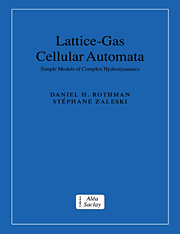Book contents
- Frontmatter
- Contents
- Preface
- Acknowledgements
- 1 A simple model of fluid mechanics
- 2 Two routes to hydrodynamics
- 3 Inviscid two-dimensional lattice-gas hydrodynamics
- 4 Viscous two-dimensional hydrodynamics
- 5 Some simple three-dimensional models
- 6 The lattice-Boltzmann method
- 7 Using the Boltzmann method
- 8 Miscible fluids
- 9 Immiscible lattice gases
- 10 Lattice-Boltzmann method for immiscible fluids
- 11 Immiscible lattice gases in three dimensions
- 12 Liquid-gas models
- 13 Flow through porous media
- 14 Equilibrium statistical mechanics
- 15 Hydrodynamics in the Boltzmann approximation
- 16 Phase separation
- 17 Interfaces
- 18 Complex fluids and patterns
- Appendix A Tensor symmetry
- Appendix B Polytopes and their symmetry group
- Appendix C Classical compressible flow modeling
- Appendix D Incompressible limit
- Appendix E Derivation of the Gibbs distribution
- Appendix F Hydrodynamic response to forces at fluid interfaces
- Appendix G Answers to exercises
- Author Index
- Subject Index
16 - Phase separation
Published online by Cambridge University Press: 23 September 2009
- Frontmatter
- Contents
- Preface
- Acknowledgements
- 1 A simple model of fluid mechanics
- 2 Two routes to hydrodynamics
- 3 Inviscid two-dimensional lattice-gas hydrodynamics
- 4 Viscous two-dimensional hydrodynamics
- 5 Some simple three-dimensional models
- 6 The lattice-Boltzmann method
- 7 Using the Boltzmann method
- 8 Miscible fluids
- 9 Immiscible lattice gases
- 10 Lattice-Boltzmann method for immiscible fluids
- 11 Immiscible lattice gases in three dimensions
- 12 Liquid-gas models
- 13 Flow through porous media
- 14 Equilibrium statistical mechanics
- 15 Hydrodynamics in the Boltzmann approximation
- 16 Phase separation
- 17 Interfaces
- 18 Complex fluids and patterns
- Appendix A Tensor symmetry
- Appendix B Polytopes and their symmetry group
- Appendix C Classical compressible flow modeling
- Appendix D Incompressible limit
- Appendix E Derivation of the Gibbs distribution
- Appendix F Hydrodynamic response to forces at fluid interfaces
- Appendix G Answers to exercises
- Author Index
- Subject Index
Summary
Phase separation—the spontaneous separation of two initially mixed fluids—is one of the most fascinating aspects of immiscible lattice-gas mixtures. As we have already seen in Chapters 9, 11, and 12, phase separation occurs as a result of a phase transition in lattice-gas models. Though the resulting phase-separation dynamics can be quite dramatic, the transition itself can be difficult to describe. In particular, non-equilibrium aspects of lattice-gas phase transitions remain to be fully addressed.
Using a combination of theoretical arguments and numerical simulation, we focus in this chapter on the characterization of phase separation in lattice gases. We begin with a brief review of a classical model of phase separation. Then, focusing on the specific case of the immiscible lattice-gas (ILG) models of Chapters 9 and 11, we detail some of the ways in which our discrete models have been shown thus far to qualitatively (and sometimes quantitatively) reproduce the non-equilibrium evolution of real phase separation.
Phase separation in the real world
Phase separation occurs when the mixed state of a mixture is unstable, so that its components spontaneously segregate into bulk phases composed primarily of one species or the other. If the instability results from a finite, localized perturbation of concentration in the mixture, it is known as nucleation. If instead the perturbation is infinitesimal in amplitude, not localized, and of sufficiently long wavelength, the instability is known as spinodal decomposition.
- Type
- Chapter
- Information
- Lattice-Gas Cellular AutomataSimple Models of Complex Hydrodynamics, pp. 203 - 219Publisher: Cambridge University PressPrint publication year: 1997

